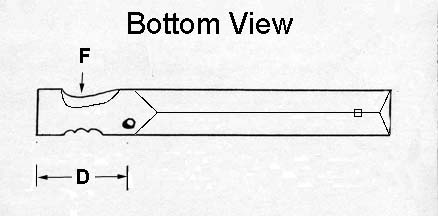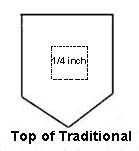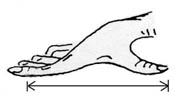

This information was originally from Bill Tcheripanoff born in Unalaska and resided in Akutan, he died in 1982. Bill passed this information on to Emil Berikoff. Emil is still making darts and throwing boards, and is happy to teach it to anyone interested.


A. The length of
an Aleut Throwing Board is set by the individuals hand size.
Stretching one's thumb and index finger along the top side of the
throwing board twice and then adding the distance from the tip of the
index finger to the *second
knuckle gives you the perfect size board
for your own hand.

B. The width of the throwing board is figured by holding the first three fingers together, this will be the general width of the board. Some Throwing Boards are wider at the finger hole than at the socket end.
C. The same
three fingers width is what determines the location of the socket from the end
of the board. The peg/notch that fits into the socket is made from hard bone,
ivory, or plastic. The design of the peg/notch depends on the type of dart/harpoon
you use.


The peg/notch fits into the socket which is a 1/4 inch square hole that passes completely through the board. The bottom of the peg is flush with the underside of the board.
D. The finger hole of the Throwing Board is located by using the stretch measurement. Measure on the top of the board the distance from the thumb to the *first joint of the index finger (*first joint from index finger tip) from the handle end of the board.
The finger hole is drilled to the side of the slot/groove. The finger hole is drilled at an angle so that the finger can enter it comfortably. Drill the finger hole from the top of the board.

E. The slot/grove end, in which the dart/harpoon rests in, is the distance of one thumb to index finger stretch from the point where the socket/peg is located (C). The depth of the groove depends on the type of darts or harpoons used. The usual depth and width of the groove is about 3/8 of an inch at the socket/peg and tapers flush above at the finger hole.

F. The indentation on the side and underside is carved out to fit the palm of your throwing hand. The thumb and finger must hold the dart so the grip area is custom carved to fit your hand comfortably thus allowing you support the dart with your middle finger and thumb.
G. The handle end of the board has a small angle to it starting from just above the finger hole to its handle end. This 6 to 8 inch section of the board should be planed or sawn so that a wedge is removed. The wedge is about 1/4 to 1/2 inches thick at the end of the board and flush to the boards surface by the finger hole.

The back of the board has a triangular ridge from the socket end to the finger hole, with the thickest part of the ridge in the middle section just above the finger hole.

The back side of the handle is carved out to fit your hand, with (F) a indentation on the side of the board for the thumb and notches on the other side for the fingers. A raised area on the bottom of the board by the thumb notch fits into your palm fold between the thumb and fingers (the life line of your hand). The top side sometimes has finger dimples or groves to fit your fingers. Basically the handle should be a very comfortable fit, and allow you to hold a dart/harpoon with your thumb and second finger.

- VOLCANO OBSERVATORY -|- UNALASKA CITY SCHOOL -|
|-
Williwaw Weather Links
-|- Unalaska Methodist Church-|
|-MUSEUM OF THE
ALEUTIANS - |- UNALASKA
VISITORS BUREAU-|
|-WORLD ATLATL
ASSOCIATION -|- HOLY
ASCENSION OF OUR LORD CATHEDRAL UNALASKA-|
|-UNIVERSITY
OF ALASKA FAIRBANKS -|-CITY
OF UNALASKA -|

![]()